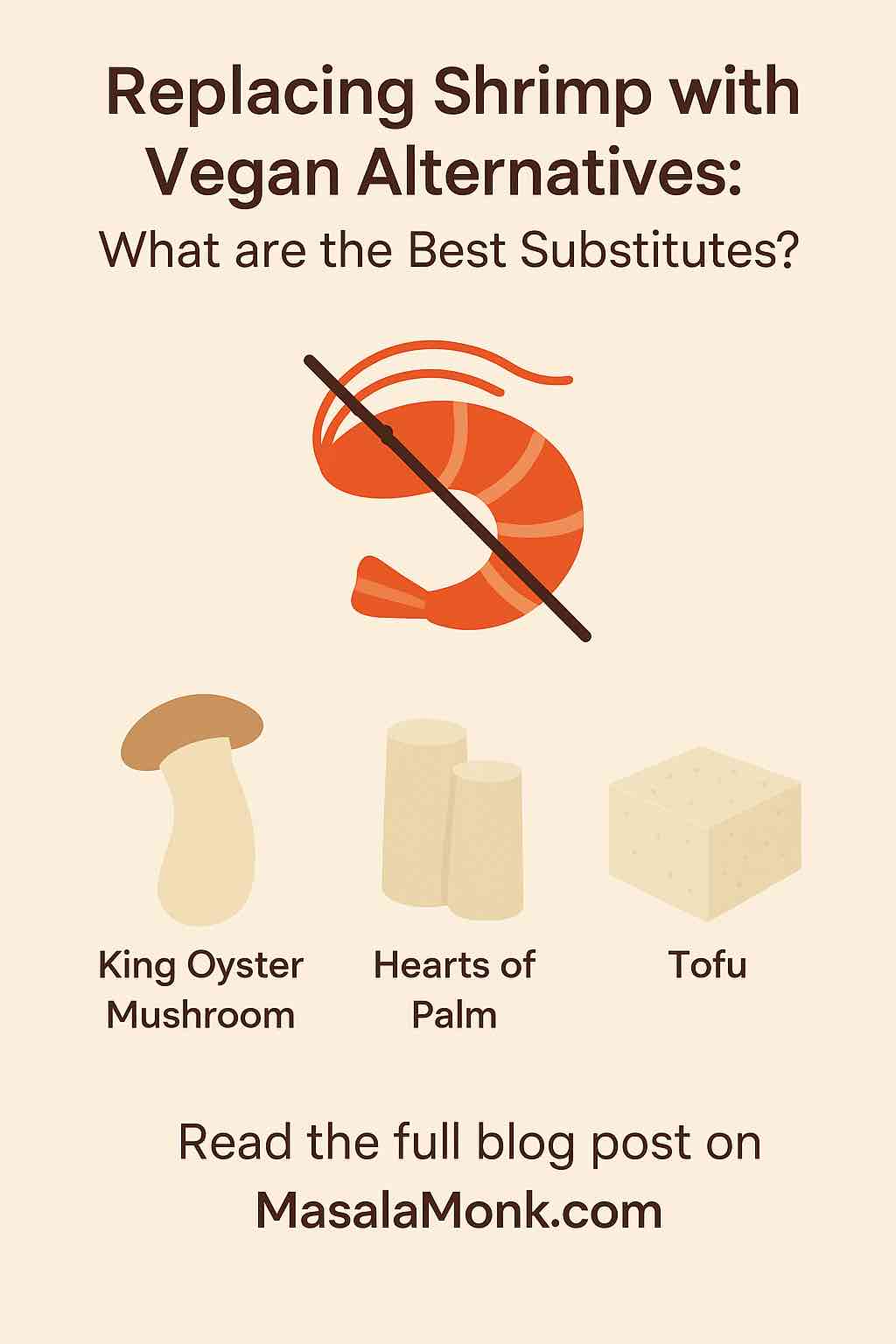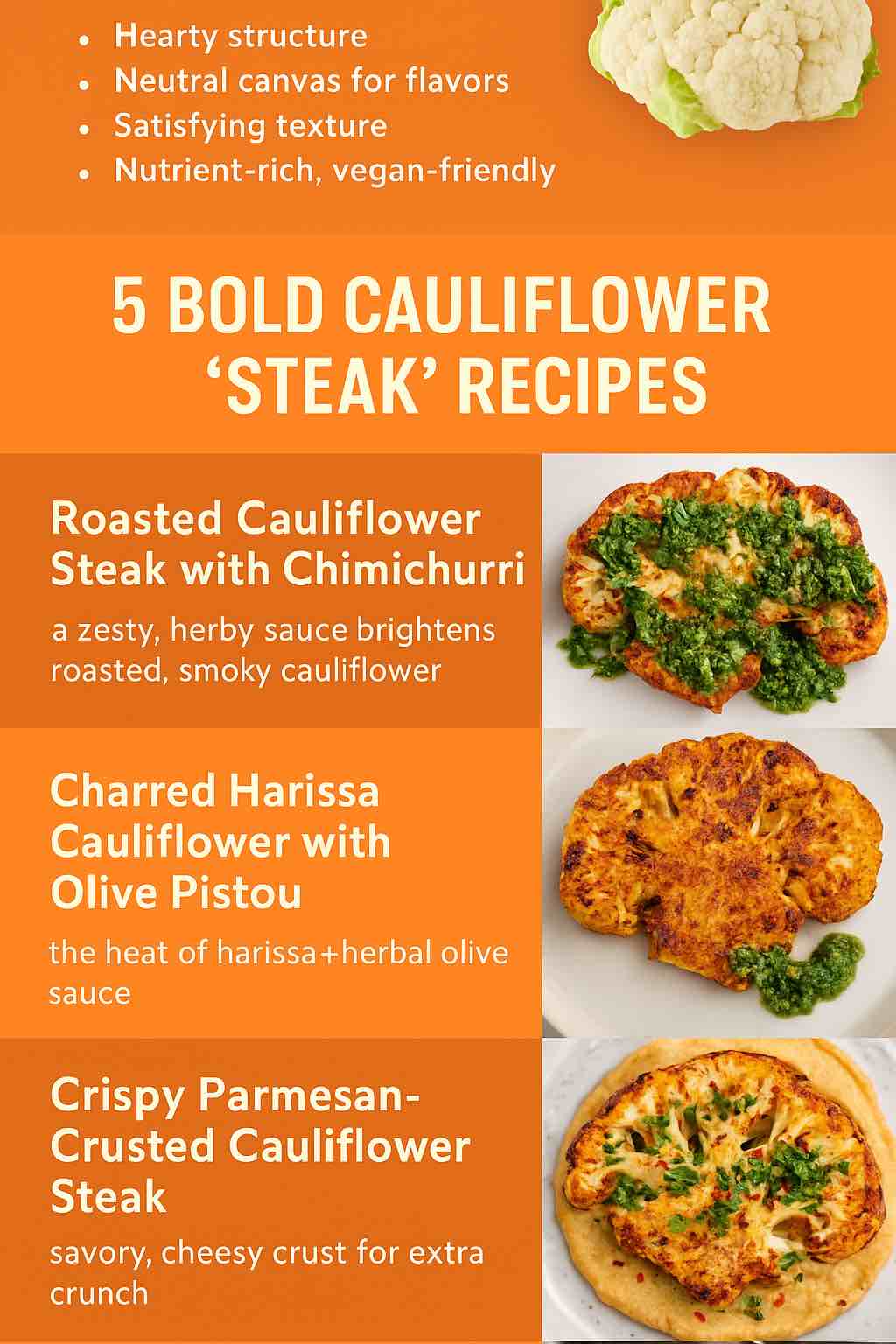
Why Plant-Based Protein? Because Food Should Fuel and Delight You
Let’s be real: figuring out what to eat every week—especially when you want more protein and less animal stuff—can feel overwhelming. Most of us aren’t training for a bodybuilding competition, but we still want to feel energized, satisfied, and maybe even impress ourselves (or our friends!) with how good plant-based meals can taste.
The truth? Plant protein isn’t just “good enough”—it’s powerful, varied, and, honestly, pretty fun once you know your options. Whether you’re a meal prepper, a busy parent, a fitness buff, or just egged out from food sensitivities, this guide is here to spark new ideas and keep your meals hearty, high-protein, and stress-free.
If you’re new to all this, you’ll love our explainer: What Is Protein? (It’s not as intimidating as it sounds!)
The 10 Best Plant-Based Protein Sources for Meal Prep
These aren’t just “swap this for that” suggestions. We’re talking about whole foods that deliver on flavor, nutrition, and convenience—plus, ways to actually use them without getting bored.
1. Lentils: The Weeknight Wonder
- Protein: About 18g per cooked cup
- Why they rock: Lentils are affordable, easy to cook in big batches, and come in varieties (green, brown, red, black) for any recipe mood.
- How to use: Whip up a comforting dal, a French-style lentil salad, or simply stir into soups for extra heft.
- Meal Prep Magic: Cook a large pot and use it for salads, bowls, and wraps all week.
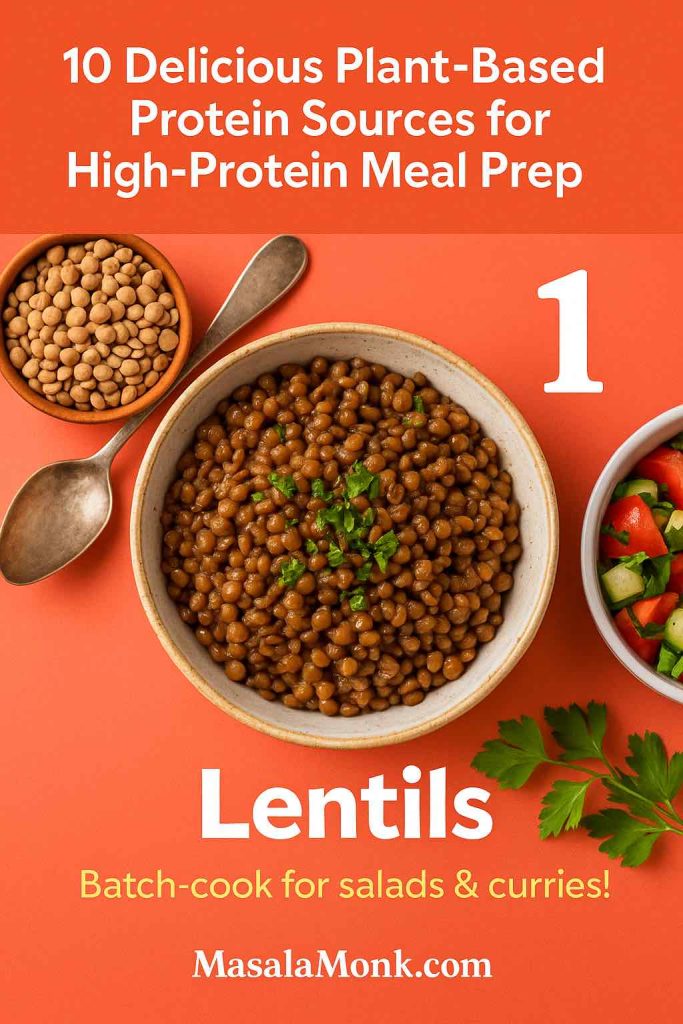
Love lentils? Try: Plant-Based High-Protein Meal Prep Ideas Using Lentils Instead of Chicken
2. Chickpeas: The All-Rounder
- Protein: About 15g per cooked cup
- Why they rock: Nutty, filling, and versatile. Perfect for curries, hummus, or crispy roasted snacks.
- How to use: Mash for “tuna” salad, blend into creamy dips, or add whole to grain bowls.
- Meal Prep Magic: Batch-cook and freeze portions for quick meals or salads.
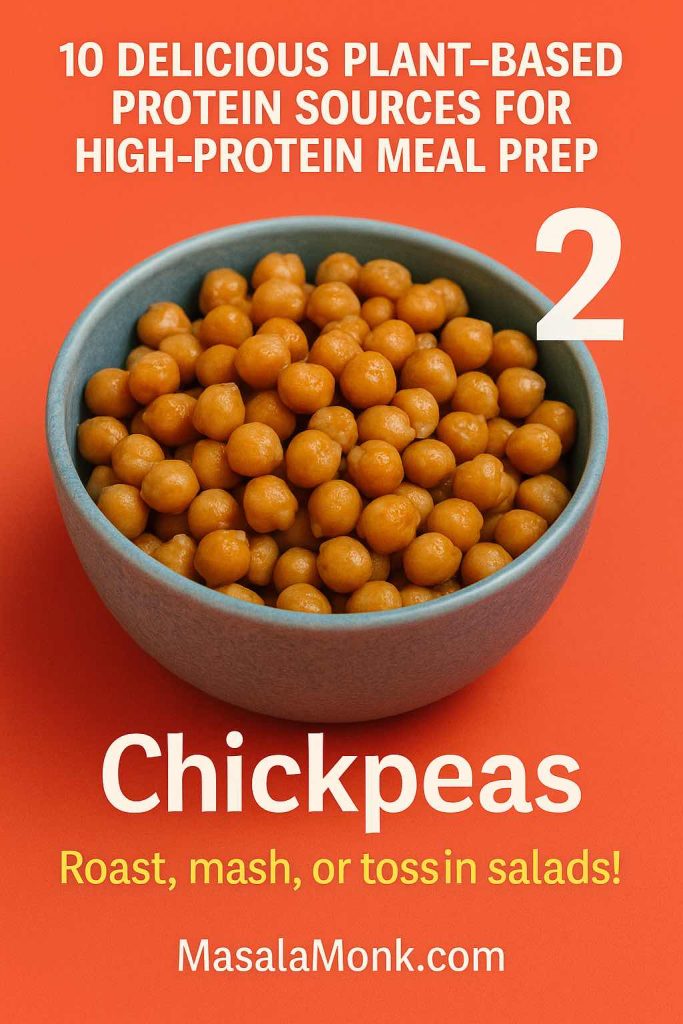
Bonus pasta hack: High-Protein Pasta Dishes: 10 Plant-Based Meal Prep Ideas
3. Black Beans & Kidney Beans: The Pantry Heroes
- Protein: Black beans ~15g/cup, Kidney beans ~13g/cup
- Why they rock: Hearty, satisfying, packed with fiber and iron.
- How to use: Chili, burritos, salads, even brownies (yes, really!).
- Meal Prep Magic: Simmer a big batch and portion out for the freezer.
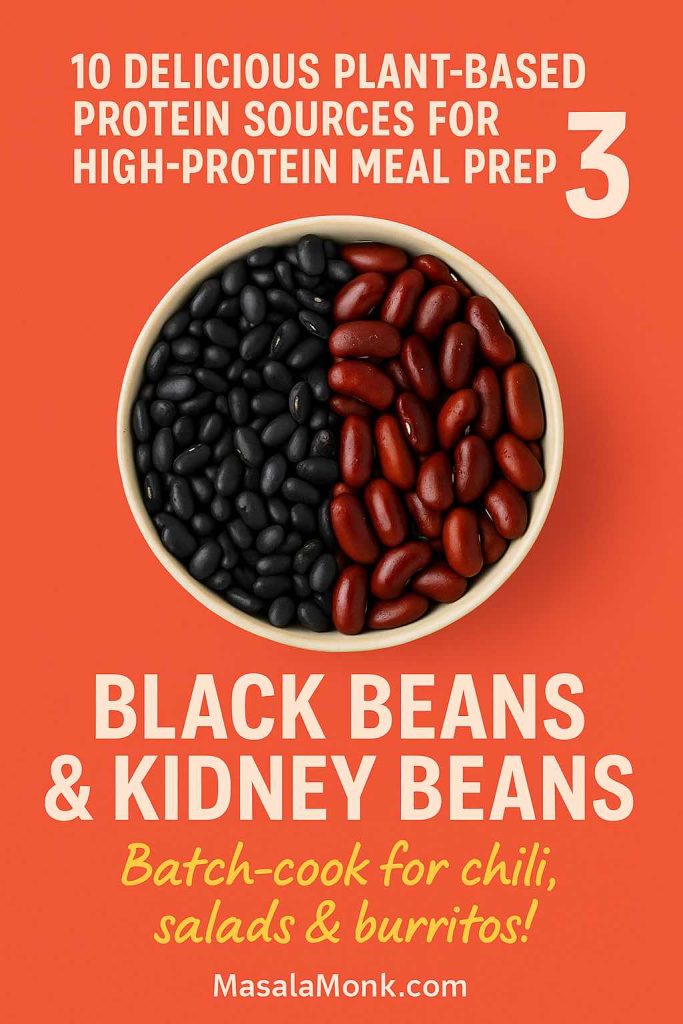
4. Tofu: The Chameleon
- Protein: About 10g per half-cup (firm tofu)
- Why it rocks: Takes on any flavor—think crispy baked, silken in smoothies, or scrambled like eggs.
- How to use: Marinate and bake, stir-fry, or blend for creamy sauces.
- Meal Prep Magic: Press, cube, and marinate tofu on Sunday for quick meals all week.
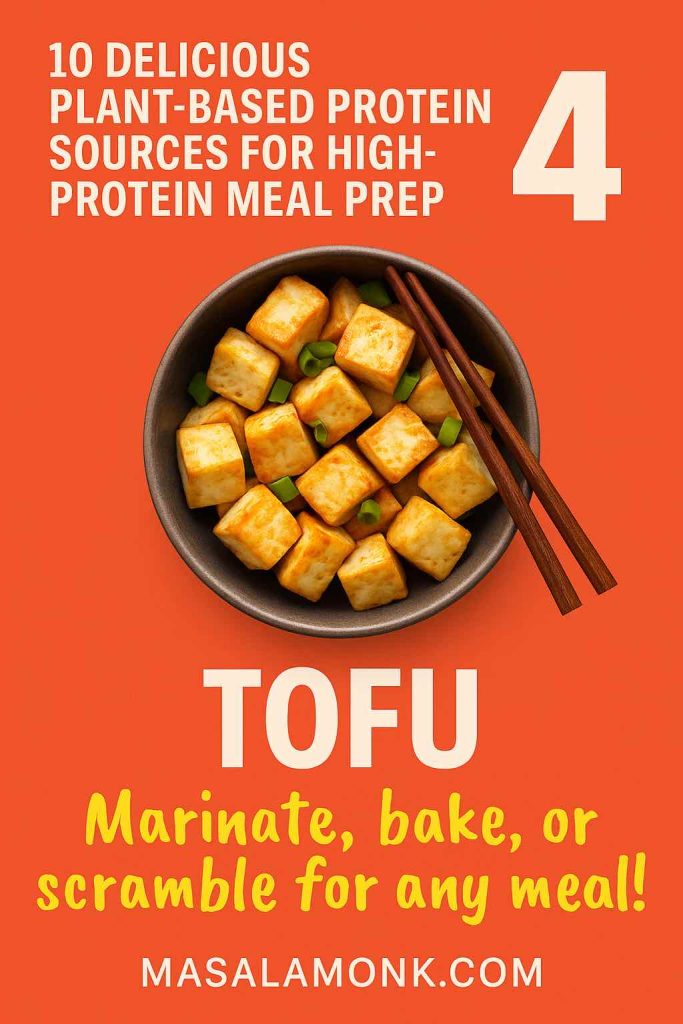
Go deeper: The Power of Tempeh: 10 High-Protein Plant-Based Meal Prep Ideas as an Alternative to Pork
5. Tempeh: The Gut-Friendly Powerhouse
- Protein: About 16g per 3 ounces
- Why it rocks: Firm, nutty, and fermented for easy digestion and gut health.
- How to use: Sauté, grill, crumble in tacos, or toss into stir-fries.
- Meal Prep Magic: Slice and marinate for easy lunchbox sandwiches or quick Buddha bowls.
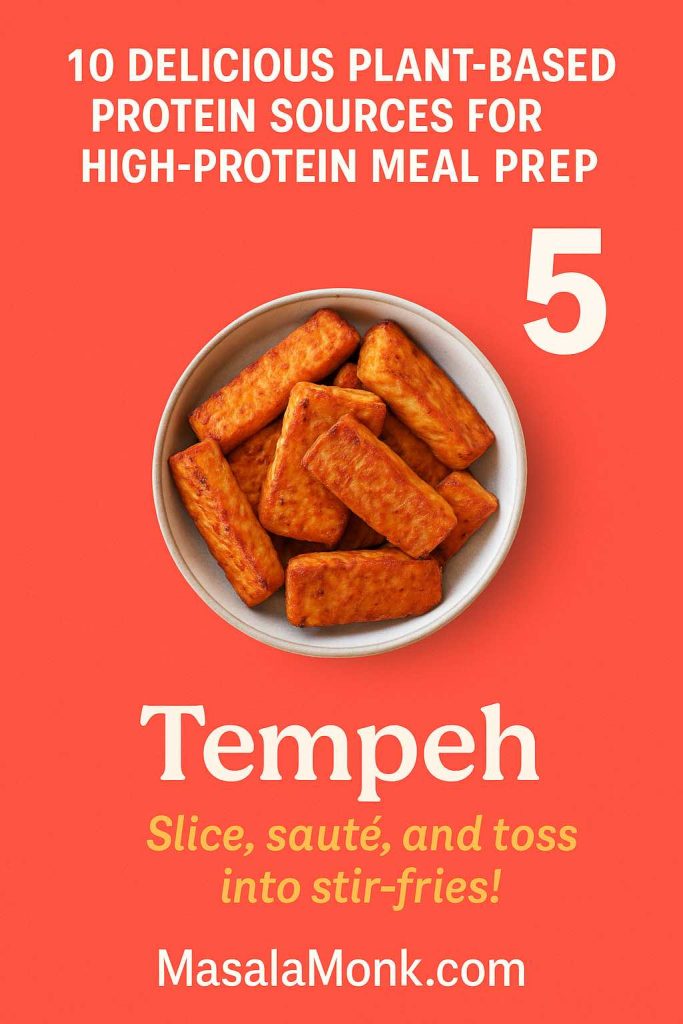
Need more inspiration? Tempeh Instead of Shrimp: 5 High-Protein Plant-Based Meal Prep Ideas
6. Edamame: The Snack You Didn’t Know You Needed
- Protein: About 17g per cooked cup (shelled)
- Why it rocks: Sweet, bright, and fun to eat. Perfect for salads, stir-fries, or solo snacking.
- How to use: Toss on salads, blend into dips, or stir into grain bowls.
- Meal Prep Magic: Keep bags of frozen edamame on hand—boil or microwave in minutes.
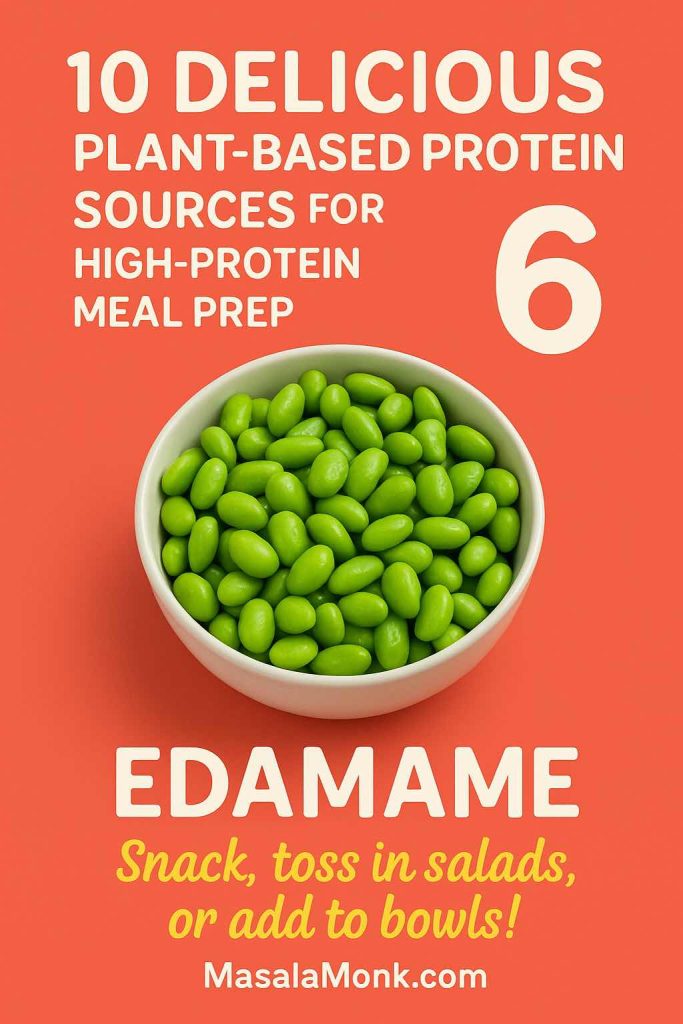
7. Quinoa: The Tiny-but-Mighty Grain
- Protein: About 8g per cooked cup
- Why it rocks: A rare complete plant protein, cooks fast, and works in sweet or savory meals.
- How to use: Breakfast porridge, salads, veggie burgers, or as a side.
- Meal Prep Magic: Make a double batch and use in everything from lunch bowls to morning oats.
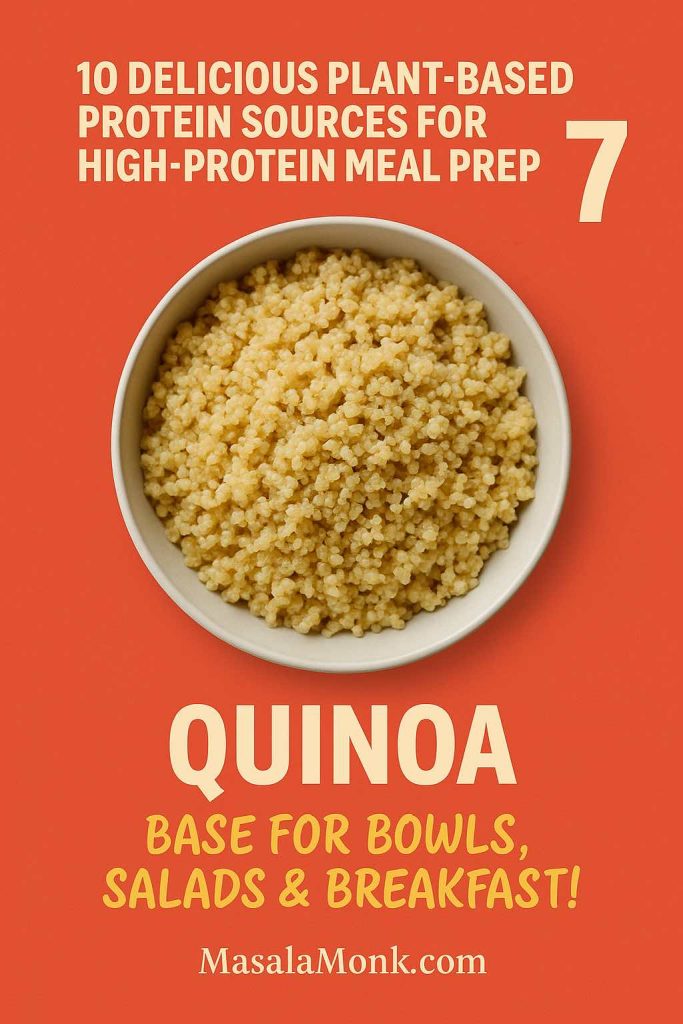
More ways to use it: 10 Plant-Based Meal Prep Ideas Using Quinoa as a Protein Source
Or try: Quinoa Instead of Chicken: 5 High-Protein Plant-Based Meal Prep Ideas
8. Nuts & Nut Butters: The Satisfying Snackers
- Protein: Almonds ~6g/oz, Peanut butter ~8g/2 Tbsp
- Why they rock: Portable, craveable, and loaded with healthy fats.
- How to use: Snack packs, breakfast toppers, or creamy sauces for noodles.
- Meal Prep Magic: Portion nut butter in small jars for quick snacks, or sprinkle chopped nuts on meals for crunch and extra protein.
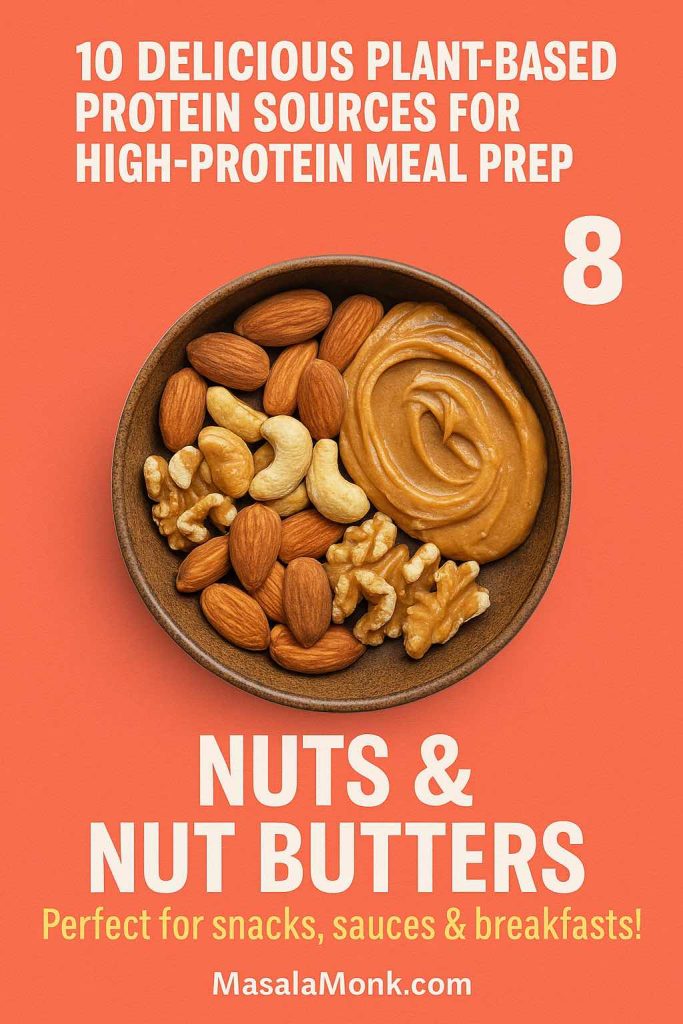
Learn more: Benefits of Nuts and Seeds – Protein-Packed Superfoods
9. Seeds: Tiny Titans of Nutrition
- Protein: Hemp ~10g/3 Tbsp, Chia ~5g/2 Tbsp, Flax ~3g/2 Tbsp
- Why they rock: High in protein, fiber, and essential fats. Great for gut and brain.
- How to use: Add to overnight oats, smoothies, or homemade energy bars.
- Meal Prep Magic: Make a week’s worth of chia pudding, or keep a “super seed mix” in the fridge to add to any meal.
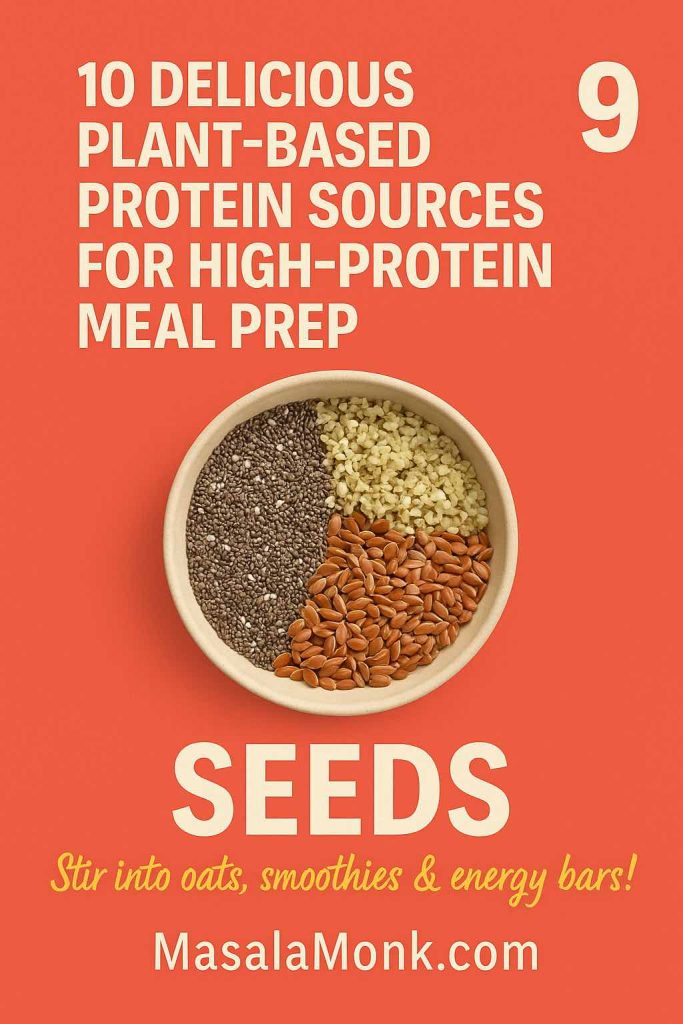
Deep dive: The Power of Chia Seeds: 5 Plant-Based High-Protein Meal Prep Ideas
10. Seitan: The Secret to Meatiness (for Gluten Lovers)
- Protein: About 21g per 3 ounces
- Why it rocks: Made from wheat gluten, seitan is unbelievably high in protein and has a chewy, meaty texture.
- How to use: Stir-fry, grill, skewer, or add to hearty stews.
- Meal Prep Magic: Sauté a big batch in your favorite marinade and use in wraps or power bowls.
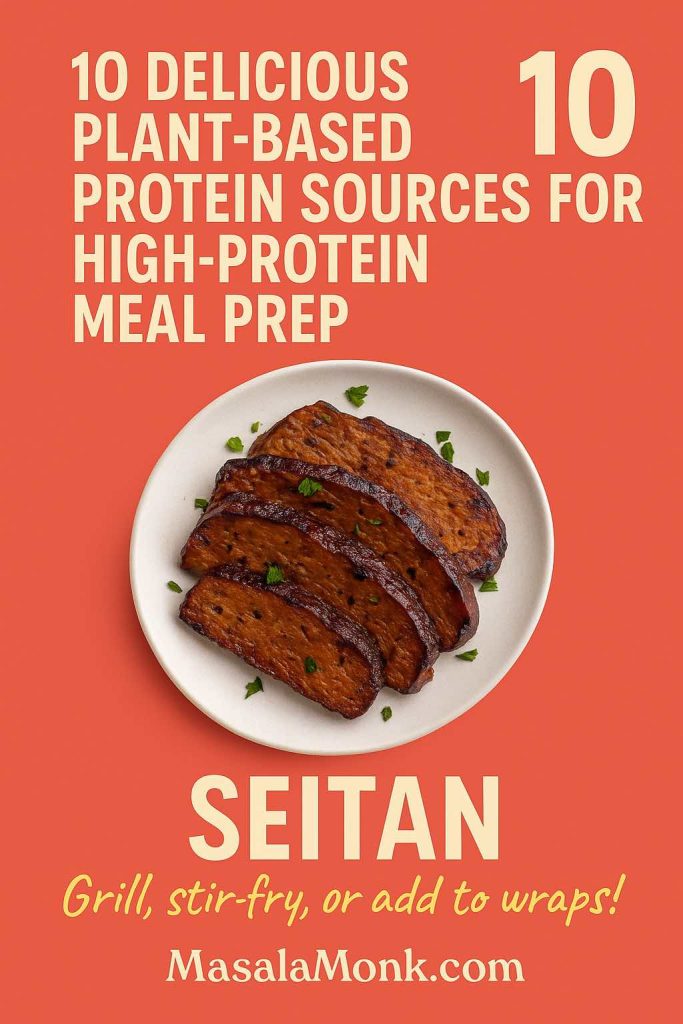
Honorable Mentions & New Favorites
- Ancient grains like amaranth and buckwheat are sneaking into more kitchens for their protein punch. Try them in grain salads or porridge. Using Ancient Grains for a Protein Punch: 10 Plant-Based Meal Prep Ideas
- Mushrooms + legumes for umami-rich meals: Mushrooms Instead of Beef: 5 High-Protein Plant-Based Meal Prep Ideas
How to Meal Prep Like a Plant-Based Pro
- Batch cooking is your best friend.
Cook lentils, beans, quinoa, and tofu in large amounts and freeze or refrigerate in portioned containers. - Mix and match.
Rotate protein sources each week to keep meals exciting and nutritionally balanced. - Invest in seasoning.
Spices, herbs, citrus, and bold dressings keep things far from boring. Your taste buds deserve variety! - Snack smart.
Make your own trail mixes, roasted chickpeas, or chia seed pudding for high-protein snacks you can grab anytime. - Be flexible.
Forgot to cook beans? Tofu, tempeh, or edamame to the rescue—quick and easy! - Cultural inspiration.
Explore protein-rich Indian dishes: 10 Vegetarian and High-Protein Meal Prep Ideas from Indian Cuisine
Let’s Talk Protein Quality and Variety
Don’t let the “complete/incomplete protein” myth stress you out. Most plant foods offer all essential amino acids in some amount, and variety ensures you get what you need. Want to geek out? The Science of Protein: Maximizing Muscle Growth and Recovery has you covered.
Goal tip: Spread your protein throughout the day (aim for 20–30g per meal if you’re active).
Real-Life Meal Prep Ideas (You’ll Actually Want to Eat!)
- Chickpea salad wraps (chickpeas, crunchy veg, tahini)
- Lentil & quinoa bowls (bulk cooked, add greens and roasted veggies)
- Spicy tofu stir-fry (with edamame and brown rice)
- Tempeh tacos (crumbled tempeh, spices, salsa, slaw)
- Breakfast chia pudding (chia seeds, plant milk, berries, nuts)
Smoothie lover? Try: 5 Turmeric and Moringa Smoothies for Weight Loss
Why Plant-Based Protein Meal Prep is a Life-Changer
It’s not just about protein grams—it’s about feeling nourished, saving money, and genuinely enjoying your food. Plant-based meal prep can help you:
- Save time during busy weeks
- Reduce food waste
- Hit your protein goals without animal products
- Get creative in the kitchen and discover new favorites
For even more protein strategies: How to Eat 100 Grams of Protein a Day
Final Thoughts: Build Your Own Protein-Packed Plate
It doesn’t matter if you’re a lifelong vegan, an adventurous omnivore, or just protein-curious—these plant-based foods belong in every kitchen. High-protein meal prep isn’t about perfection. It’s about showing up for yourself, one delicious meal at a time.
What’s your favorite plant protein hack? Drop a comment, tag us in your meal prep creations, and let’s keep inspiring each other to eat well—together.
Hungry for more? Browse our meal prep and protein archives, and don’t be afraid to try something new next week. Your future self (and your taste buds) will thank you.
FAQs: Plant-Based Protein for High-Protein Meal Prep
1. Can I get enough protein on a plant-based diet?
Yes! With variety and a little planning, you can easily meet your protein needs using foods like beans, lentils, tofu, tempeh, nuts, seeds, quinoa, and more. Many athletes and active individuals thrive on plant-based protein sources.
2. Which plant foods are complete proteins?
Quinoa, soy products (tofu, tempeh, edamame), hemp seeds, chia seeds, and amaranth are all complete proteins, meaning they contain all nine essential amino acids.
3. How much protein do I need each day?
Most adults need 0.8–1.2 grams of protein per kilogram of body weight, but active people may require more. That’s about 50–80g for most. Spreading intake across meals helps with absorption and muscle maintenance.
4. What’s the best way to meal prep plant-based proteins?
Batch-cook staples like lentils, beans, and quinoa. Roast chickpeas or tofu, and make sauces or dressings ahead. Freeze portions for quick meals all week.
5. Do I need protein powder on a plant-based diet?
Not necessarily! Whole foods usually provide plenty, but protein powder is a convenient option if you struggle to meet your needs or have higher protein goals.
6. Can I combine different plant proteins for better nutrition?
Yes—combining foods like rice and beans, or hummus with whole-grain pita, can create a complete protein profile, but variety over the day is usually enough.
7. Are there plant-based protein options for people with soy or gluten allergies?
Absolutely. Lentils, beans, quinoa, nuts, seeds, and buckwheat are all soy- and gluten-free options rich in protein.
8. Will eating more plant protein help with weight loss?
Plant-based proteins are often lower in calories and higher in fiber, which can help you feel fuller for longer and support healthy weight loss.
9. What about iron and B12 on a plant-based diet?
Beans, lentils, seeds, and greens are great iron sources, but plant iron isn’t as easily absorbed. Pair with vitamin C-rich foods. B12 needs to come from fortified foods or supplements, since plants don’t provide it.
10. Are there quick plant-based high-protein snacks I can prep?
Yes! Try roasted chickpeas, nut butter with fruit, chia pudding, trail mix, or protein balls made from oats, seeds, and dried fruit.

